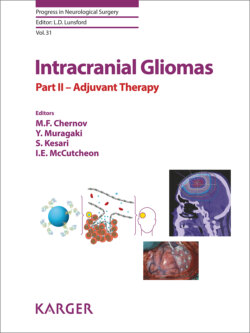Intracranial Gliomas Part II - Adjuvant Therapy

Реклама. ООО «ЛитРес», ИНН: 7719571260.
Оглавление
Группа авторов. Intracranial Gliomas Part II - Adjuvant Therapy
Progress in Neurological Surgery
Intracranial Gliomas
Contents
Series Editor’s Note
Preface
Pathology and Genetics of Gliomas
Abstract
Introduction
Contemporary Histopathological Classification of Gliomas
Astrocytomas (WHO Grades I–IV)
Oligodendrogliomas (WHO Grades II and III)
Oligoastrocytomas (WHO grades II and III) and Their Controversy
Gliomatosis Cerebri
Ependymomas (WHO Grades I–III)
Other Gliomas
WHO Histopathological Tumor Grading
Major Molecular Alterations in Gliomas
General Overview of Main Molecular Alterations in Gliomas
IDH1/IDH2
TP53
ATRX
1p/19q
TERT
CDKN2A
Glioblastoma-Related Molecular Alterations
MGMT
BRAF
Tuberous Sclerosis Complex
Malignant Progression of Gliomas
Genotype-Based Prognostic Subgroups of Gliomas
Glioma-CpG Island Methylator Phenotype
Pediatric Gliomas
Future Perspectives
Integrated Histopathological Diagnosis
Pitfalls
Conclusions
Acknowledgments
Disclosure Statement
References
Fractionated Radiotherapy of Intracranial Gliomas
Abstract
Introduction
Radiotherapy Basics
Glioblastoma (WHO Grade IV)
Dose
Field Size
Modern Techniques
Anaplastic Gliomas (WHO Grade III)
Radiation Technique
Low-Grade Gliomas (WHO Grade II)
Radiation Technique
Toxicity
Conclusion
Disclosure Statement
References
Stereotactic Radiosurgery in the Multimodality Management of Residual or Recurrent Glioblastoma Multiforme
Abstract
Introduction
Rationale for Radiosurgery in Patients with Malignant Gliomas
Patient Selection
Reported Results of Radiosurgery for Glioblastoma
The University of Pittsburgh Experience
Overall Survival
Progression-Free Survival
Imaging
Recursive Partitioning Analysis
Criticism of Radiosurgery for Glioblastoma
Radiosurgery in Combination with Bevacizumab
Recurrence Pattern after Radiosurgery for Glioblastoma
Rationale for a Prospective Clinical Trial on Radiosurgery for Glioblastoma
Conclusion
Disclosure Statement
References
Stereotactic Radiosurgery of Intracranial Low-Grade Gliomas
Abstract
Introduction
Pilocytic Astrocytoma (WHO Grade I)
Subependymal Giant Cell Astrocytoma (WHO Grade I)
Diffuse Astrocytoma (WHO Grade II)
Oligodendroglioma (WHO Grade II)
Ependymoma (WHO Grade II)
Radiosurgery of Low-Grade Gliomas in Specific Locations. Anterior Optic Pathway Gliomas
Tectal Gliomas
Intrinsic Brainstem Gliomas
Conclusion
Disclosure Statement
References
Brachytherapy of Intracranial Gliomas
Abstract
Introduction
General Overview of Brachytherapy for Intracranial Gliomas
Indications
Technique
Brachytherapy of Low-Grade Gliomas
Pilocytic Astrocytoma (WHO Grade I)
WHO Grade II Gliomas
Brachytherapy of High-Grade Gliomas
Complications and Their Avoidance
Conclusions
Acknowledgments
Disclosure Statement
References
Irradiation of Intracranial Gliomas in Children
Abstract
Introduction
Low-Grade Gliomas
Imaging
General Management Strategy
Dose-Response Effects and Dose Prescription
Treatment Fields
Outcome after First-Line Radiotherapy
Outcome after Radiotherapy following Failed Chemotherapy
Proton Therapy, Brachytherapy, and Stereotactic Radiosurgery
Late Radiation-Induced Adverse Effects
High-Grade Gliomas
Dose-Response Effects and Dose Prescription
Treatment Fields
Brainstem Gliomas
Dose–Response Effects and Dose Prescription
Treatment Fields
Re-Irradiation
Conclusions
Disclosure Statement
References
Role of Radiosensitizers in Radiation Treatment of Gliomas
Abstract
Introduction
Temozolomide
Glioblastoma
Anaplastic Gliomas
Low-Grade Gliomas
PARP Inhibitors
Antiangiogenic Therapies
Bevacizumab
Cediranib
mTOR Inhibitors
EGFR Signaling Inhibition
Other Agents. Integrin Inhibitors
Texaphyrins
Overcoming Hypoxia
Histone Deacetylase Inhibitors
Conclusion
Disclosure Statement
References
Chemotherapy of High-Grade Astrocytomas in Adults
Abstract
Introduction
Types of the Chemotherapeutic Drugs and Specific Agents Relevant to Therapy of High-Grade Gliomas. Alkylating Agents
Microtubule Inhibitors
Topoisomerase Inhibitors
Metals
Historical Studies on Chemotherapy of High-Grade Gliomas
Newly Diagnosed Gliomas
Recurrent Gliomas
Current Therapy of Newly Diagnosed Glioblastoma
Temozolomide
Bevacizumab
Alternative Regimens for Tumors without MGMT Promoter Methylation
NovoTTF-100A
Current Therapy of Elderly Patients with Newly Diagnosed Glioblastoma
Current Therapy of Recurrent Glioblastoma
Temozolomide
Bevacizumab
Other Antiangiogenic Therapies
Local Chemotherapy
Current Therapy of Anaplastic Astrocytoma
Newly Diagnosed Anaplastic Astrocytoma
Recurrent Anaplastic Astrocytoma
Summary and Conclusions
Disclosure Statement
References
Chemotherapy of Diffuse Astrocytoma (WHO grade II) in Adults
Abstract
Introduction
Observation
Radiotherapy
Combination of Radiotherapy with Nitrosourea-Based Chemotherapy
Temozolomide
RTOG 0424 Trial
Other Trials
Conclusion
Disclosure Statement
References
Chemotherapy of Oligodendrogliomas
Abstract
Introduction
Chemotherapeutic Regimens for Oligodendroglial Tumors
Anaplastic Oligodendroglioma (WHO grade III)
PCV vs. Temozolomide
Oligodendroglioma (WHO grade II)
Temozolomide
Timing of Treatment
Salvage Chemotherapy for Recurrent Oligodendroglial Tumors
Antiangiogenic Therapy
Conclusion
Disclosure Statement
Acknowledgment
References
Chemotherapy of Intracranial Gliomas in Children
Abstract
Introduction
Low-Grade Gliomas
High-Grade Gliomas
Non-Pontine High-Grade Gliomas in Older Children
Non-Pontine High-Grade Gliomas in Infants
Diffuse Intrinsic Pontine Gliomas
Conclusion
Disclosure Statement
References
Perspectives of Personalized Chemotherapy of Gliomas Based on Molecular Tumor Profiling
Abstract
Introduction
Role of Molecular Markers in Glioblastoma. MGMT Promoter Methylation
1p/19q Co-Deletion
IDH1/IDH2 Mutations
Elderly Patients with Glioblastoma
Role of Molecular Markers in Anaplastic (WHO Grade III) Gliomas. MGMT Promoter Methylation
1p/19q Co-Deletion
IDH1/IDH2 Mutations
Role of Molecular Markers in Low-Grade (WHO Grade II) Gliomas
MGMT Promoter Methylation
1p/19q Co-Deletion
IDH1/IDH2 Mutations
Conclusions
Disclosure Statement
References
Antiangiogenic Therapy of High-Grade Gliomas
Abstract
Introduction
Angiogenesis in High-Grade Gliomas
Mechanisms of Antiangiogenic Therapy for High-Grade Gliomas
VEGF Inhibitor Bevacizumab
Bevacizumab in Recurrent Glioblastoma
Bevacizumab in Newly Diagnosed Glioblastoma
Bevacizumab in Recurrent Anaplastic Gliomas
Bevacizumab for CNS Radiation Necrosis
Aflibercept
VEGFR and Other Tyrosine Kinase Receptor Inhibitors
Integrin Inhibitors
Resistance Mechanisms to Antiangiogenic Agents
Tumor Response Assessment
Biomarkers
Toxicities
Conclusion and Future Directions
Acknowledgment
Disclosure Statement
References
Search for More Effective Chemotherapeutic Regimens for Gliomas: Challenges and Hopes
Abstract
Understanding the Enemy
A Better Strategy
The Challenges
The Way Forward
Conclusion
Disclosure Statement
References
Physical and Psychological Rehabilitation of Patients with Intracranial Glioma
Abstract
Introduction
Importance of Rehabilitation Treatment
Goals of Rehabilitation Treatment
Assessment of Presenting Symptoms
Rehabilitation of Patients with Motor Deficit
Rehabilitation of Patients with Sensory Deficit
Rehabilitation of Patients with Cranial Nerves’ Deficit
Inhibition of the Neuroinflammatory Reaction
Cognitive Rehabilitation of Patients with Glioma
General Symptoms and Their Physical Management
Massage Therapy
Physical Workload and Exercises
Psychological Alterations and Their Correction
Attitude and Personality Reaction to the Disease
Behavioral Problems
Fears
Basic Principles of Supportive Psychotherapy
Conclusions
Acknowledgments
Disclosure Statement
References
Palliative and Supportive Care of Patients with Intracranial Glioma
Abstract
Introduction
Current Status of Palliative and Supportive Care in Neuro-Oncology
Communication and Psychological Support
End-of-Life Issues
Epilepsy
Dysphagia
Alterations of Consciousness
End-of-Life Treatment-Decision Making
Quality of Care at the End of Life
Conclusions
Disclosure Statement
References
Author Index
Subject Index
Отрывок из книги
Vol. 30
Intracranial Gliomas
.....
•TERT promoter wild-type, EGFR-amplified (median overall survival 13.3 months).
In general, absence of both TERT promoter mutations and EGFR amplification (21% of cases) was associated with significantly longer survival of patients, thus the two latter groups of tumors might be combined.
.....